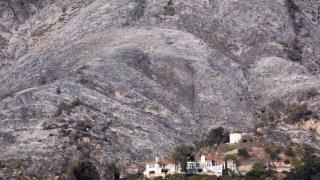
Hillsides stripped of vegetation are prone to slides that can carry trees and other debris.
Here are some tips from Chief Sam.
- Be prepared to evacuate. Listen to local authorities and leave if you are told to evacuate.
- Decide in advance where you would go in case you can’t return home for weeks or months.
- Inspect: Look around home and property for landslide warning signs such as cracks or bumps appear on hill slopes, ground or roads; water or saturated ground in areas not normally wet; evidence of slow, downhill movement of rock and soil; tilted trees, poles, decks, patios, fences or walls; and doors and windows stick or cracks appear on walls.
During a Mudflow or Landslide
- Listen for trees cracking, rocks banging together or water flowing rapidly (especially if near a stream or river). Ddebris flow may be close by.
- Move it! Whether you are in a vehicle, outside or in your home—get to safer ground.
- Be small. If there is no way to escape, curl into a tight ball and protect your head the best you can.
- Listen to local radio and TV reports that will keep you posted on latest updates or check with your local police or fire departments.
Things to Watch For
- Flooding usually occurs after landslides or debris flow.
- Damaged areasL Roadways and bridges may be buried, washed out or weakened—and water, gas and sewer lines may be broken.
- Downed power lines—Report them to power company
- Inspect: Look for damage around home and property and watch for new landslide warning signs.
- Check foundation, chimney, garage and other structures.
- Report any broken utility lines or damaged roads to local authorities.
- Watch for tilted trees, poles, decks, patios, fences or walls.
- Notice doors or windows stick, cracks appear, etc.
Turn Around, Don't Drown
Local
Get Los Angeles's latest local news on crime, entertainment, weather, schools, COVID, cost of living and more. Here's your go-to source for today's LA news.
Flash floods are the No. 1 storm-related killed in the United States. In the last three years, flooding has taken the lives of more than 100 people in the U.S. each year, and the numbers are growing as climate change increases the number of days with extremely heavy precipitation.
Eighty percent of flood deaths occur in vehicles, and most happen when drivers make a single, fatal mistake – trying to navigate through floodwaters.
Do you know what 6 – 12 and 18 add up to? Danger!
Six inches of moving water can knock you off your feet. Twelve inches of moving water can move a small car. Eighteen inches of moving water can move a large vehicle, truck or SUV.
Watch for the Following Signs
- Unusually hard rain over several hours
- Steady substantial rain over several days
- A monsoon or other tropical system affecting your area
- A weather report
- Water rising rapidly in streams and rivers
In hilly terrain, flash floods can strike with little or no advance warning. Distant rain may be channeled into gullies and ravines, turning a quiet stream into a rampaging torrent in minutes. Never camp on low ground next to streams since a flash flood can catch you while you’re asleep.
Do not driver through flooded areas, =even if it looks shallow enough to cross. The large majority of deaths due to flash flooding occur with people driving through flooded areas. Roads concealed by water may not be intact. Turn Around, Don’t Drown!
- If the vehicle stalls, leave it immediately and seek higher ground. Rapidly rising water may engulf the vehicle and its occupants and sweep them away. Remember it’s better to be wet than dead.
- Do not allow children to play around streams, drainage ditches or viaducts, storm drains, or other flooded areas.
- Be especially cautious at night. It’s harder to recognize water danger then.
- Don’t try to outrace a flood on foot. If you see or hear it coming, move to higher ground immediately.
When Hiking, Consider This
- Wait for everyone in the crew to arrive at stream, and make a determination to cross.
- Do not walk through a flowing stream on foot where water is above your ankles.
- When walking through or on rocks or logs over a stream, loosen pack buckles so if you fall you can easily get away from your pack and it will not drag you under.
- Wait for everyone to cross before continuing (in case the last person needs assistance).
- Be familiar with the land features where you live, work, and play. It may be in a low area, near a drainage ditch or small stream, or below a dam. Be prepared!
Stay tuned to your KNBC4 news or the NOAA Weather Radio for the latest statements, watches and warnings concerning heavy rain and flash flooding in your area, report it to the National Weather Service.
Campers/hikers should always determine if local officials, such as park rangers, post local cautions and warnings. This goes along with — in those areas where it’s required — completing any local tour/entrance/trip plan.
Sam DiGiovanna is a 35-year fire service veteran. He started with the Los Angeles County Fire Department, served as Fire Chief at the Monrovia Fire Department and currently serves as Chief at the Verdugo Fire Academy in Glendale.



